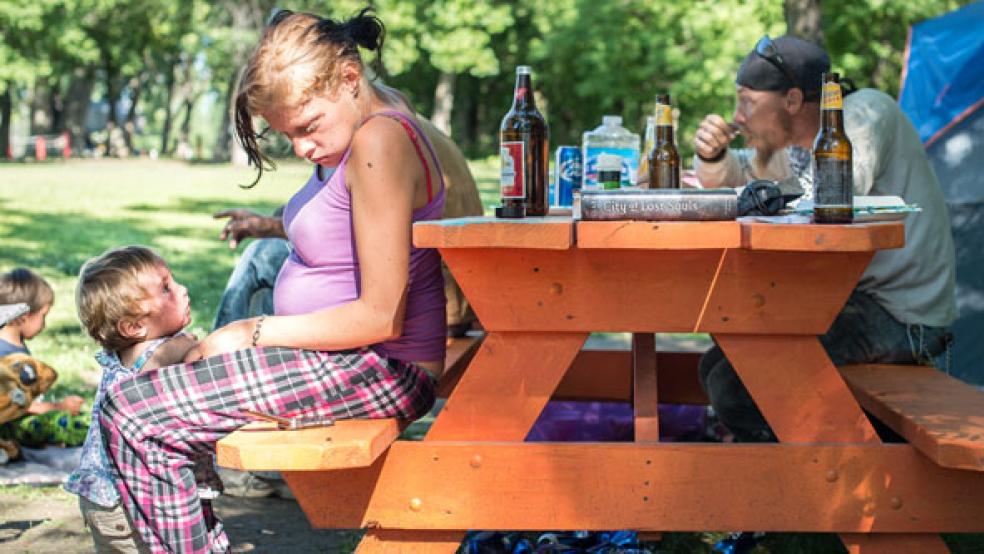Seventy miles from the Canadian border, the town of Williston, North Dakota, is raking it in. New technology has allowed energy companies to tap into millions of barrels of oil in the region, and in the process, they’ve funneled millions of dollars into the local economy. In the past five years, 450 million barrels of oil have been extracted, and the boom has generated over 75,000 new jobs, padded the area’s tax revenues, and spurred hundreds of new businesses. Average wages in the region have more than tripled in the past decade, going from $24,841 in 2002, to $78,364 last year.
Everywhere you look, people are working and spending money. Homes are being purchased seconds after they hit the market, car dealerships can’t keep their new trucks in the lot, and restaurants are busier than they’ve ever been. Even the local McDonald’s has become one of the highest-grossing McDonald’s in the country.
But not everyone is prospering from the boom.
At first look, Trenton Lake Campground appears to be a typical American summer camp spot: There are swing sets by the lake, wooden picnic tables and a few tents scattered across a grassy field. But the majority of the men, women and families staying there aren’t on vacation. They have no place to live.
RELATED: WHY NORTH DAKOTA GAS COMPANIES HAVE MONEY TO BURN
One family of seven from Utah, with a 3-year old toddler and an 11-month old infant, has been staying at the campground for two weeks, living out of their van and a small tent. Like many in their situation, the Andresons came to find better employment opportunities in North Dakota, and although the dad has been working as a welder, they haven’t saved up enough to afford the sky-high local rents, which average $3,000 a month for a three-bedroom. Even boxy mobile dwellings called “skid shacks,” brought in by companies to house temporary workers, cost about $2,000 a month. The Andreson family has until September 1, when the campground closes and temperatures drop dramatically, to find a better living situation.
While counting the number of the homeless in North Dakota’s boom region is difficult, state-wide estimates from the North Dakota Coalition for Homeless People show a troubling increase – unsheltered individuals (which include those sleeping in cars, tents and trailers with no operating utilities) went from 832 in 2008 to 1,433 in January of this year, a 72 percent increase. By comparison, Minnesota, a state nearly eight times the population of North Dakota, has 2,500 unsheltered.
THE BIRTH OF A BOOMTOWN
The problem is simply a matter of supply and demand. In 2007, Williston was a small prairie town of around 13,000 people, and for years locals had watched the town’s population slowly decline after a short oil boom in the 1980s went bust. No one in town had any idea they were about to become the center of a major black-gold rush, attracting thousands from all over the country looking for opportunity.
RELATED: 11 SHOCKING FACTS ABOUT THE NORTH DAKOTA OIL BOOM
When the jobseekers came, available housing quickly filled up and landlords hiked their rents, realizing they could still fill properties after doubling and tripling the price. In a matter of months, a modest two-bedroom apartment went from about $500 to $2,500 a month, forcing long-time residents out and preventing anyone with a lower income or blemished credit history from renting. Hundreds took to their campers, cars or tents and did what they could to survive. At one point, the local Walmart’s parking lot looked like a trailer park, and a tent city cropped up by the library – but unlike the tent cities of the recession, it was one where most of the inhabitants had jobs.
The city has been busy building more housing, issuing a record $470 million worth of building permits in 2012. Construction has been slow, though, and the constant flow of newcomers hasn’t stopped. Even though a number of new housing developments have opened up, prices haven’t fallen. In 2012, facing a growing number of complaints from shoppers, Walmart kicked the overnighters out of their parking lot. Soon, the city followed suit, banning people from sleeping in their cars, tents or unhooked trailers. Signs reading “No Overnight Parking” now speckle the city’s parking lots.
“People in Williston are being forced to be transient,” says Joshua Stansbury, who helps run the local Salvation Army. “They spent their last dollars getting up here, and they don’t have anywhere to go.”
Many long-time Williston residents who didn’t buy a home before the boom are also finding themselves homeless or living in campers. Rhonda Combs and her family had lived in their three-bedroom apartment for 10 years when their landlord suddenly doubled the rent to $3,500, forcing them to move into a camper in Rhonda’s parents’ backyard. Rhonda grew up in Williston and works at a local carpet cleaning business, and her husband works at the Parks and Recreation District. “We’re both working, but neither one of us is making oil field money,” she told the local paper. “I didn’t ever expect to be 36 and having to live with family because of greed in this town.”
The city has no homeless shelter, and though the city council has discussed building one, many residents worry that if they build it, more homeless workers from all over America will come.
A CHURCH STEPS IN
At a small Lutheran church in town, it’s pouring rain as a group of men huddle by the door waiting to be let in. Inside, socks hang on the back of chairs and sleeping bags lie on the ground, tucked between tables. Around 29 men and women now sleep here at night – the church has become the closest thing the city has to a homeless shelter. At one point 56 people were sleeping at the church, overflowing into the hallways and closets. The city considered that number a code violation and limited the number to 29.
Pastor Jay Reinke, who runs the makeshift shelter, is facing being shut down because he doesn’t have showers in the building. “These are husbands and fathers who are here to serve their families,” Reinke says. “They’re people who need an income and want to work, and it’s our duty to serve them.” Nearly every day he has to tell newcomers that the church is full. “Imagine having to turn people away in this?” he asks, gesturing to the door while a thunderstorm with 40-mile-an-hour winds rages outside.
The local Salvation Army has increased its budget from $40,000 in 2010 to $196,000 in 2012 to help with the influx. But without housing, there’s only so much it can do. “We can help them with other basic needs like food,” says Stansbury, “but not shelter.” This past winter, having few other options, the Salvation Army started buying one-way tickets out of town for the new arrivals who couldn’t find a roof over their heads. With temperatures known to drop below -40° F, not having a place to live quickly becomes dangerous. “I’ve talked people who’ve come from Florida and Jamaica, and even for people who are used to winter, it’s very different than a North Dakota winter,” says Stansbury.
If the city shuts the church’s shelter down, Reinke says he’ll give it a month to wind down. Although he’s watched dozens of men and women find jobs and homes after staying at his church, he’s also had many men sleep at the church for months, never finding more than part-time day-labor gigs, and he’s had to ask them to leave. A few men have gone missing after leaving the church, and he worries that one committed suicide. “This is a hard place,” he says. “These are people who are trying to change their lives and need our help.”





